Nineteenth Century
Commercial Telegraph Codes
I was randomly browsing old publications online when I ran across this ad. Thinking about the topic of Communication Codes, I found it hard to believe we had never covered it at WU. But apparently not.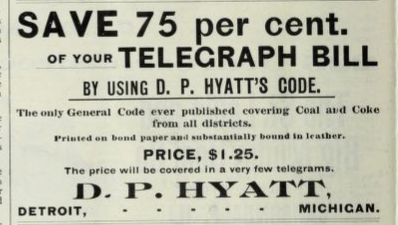
In telecommunication, a commercial code is a code once used to save on cablegram costs.[1]...These codes turned complete phrases into single words (commonly of five letters). These were not always genuine words; for example, codes contained "words" such as BYOXO ("Are you trying to weasel out of our deal?"), LIOUY ("Why do you not answer my question?"), BMULD ("You're a skunk!"), or AYYLU ("Not clearly coded, repeat more clearly.").
Here is a page linking to many digitized volumes.

Posted By: Paul - Tue Mar 02, 2021 -
Comments (0)
Category: Business, Technology, Codes, Cryptography, Puzzles, Riddles, Rebuses and Other Language Alterations, Nineteenth Century, Twentieth Century
The Snore Consumer
I've come across reports in early 20th-century newspapers of an invention, designed to stop snoring, that worked by directing the sounds of the snoring into the snorer's own ear.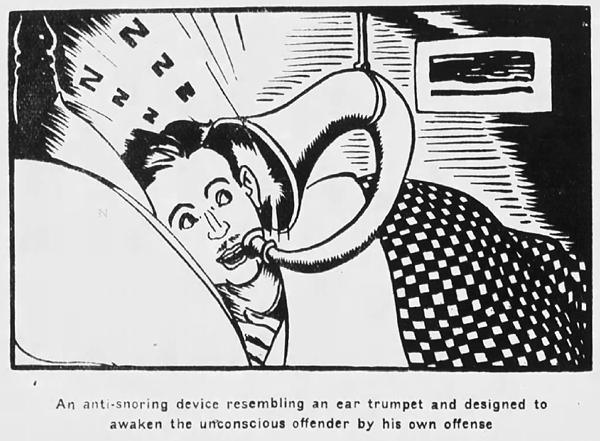
Oakland Tribune - Nov 26, 1933
I'm not sure if anyone ever really built this device, or if it was just a joke repeated by reporters.
The earliest report of it I've been able to find ran in newspapers in 1871. It attributed its invention to an unnamed woman from Iowa. However, I haven't been able to find a record of anything resembling this in the U.S. Patent Office, although there are numerous patents for anti-snoring devices.
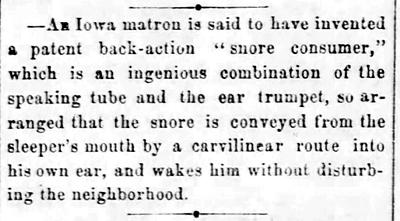
Atchison Daily Champion - Feb 24, 1871
Posted By: Alex - Thu Feb 25, 2021 -
Comments (0)
Category: Inventions, Patents, Sleep and Dreams, Nineteenth Century, Cacophony, Dissonance, White Noise and Other Sonic Assaults
The Soot-Bag System
In the early days of rail travel, people who had the financial means to travel first class often went third-class, to save some money. To discourage this practice some British railway companies adopted the "soot-bag system". They would hire a chimney sweep to travel in the third-class carriage and shake out the contents of his bag, getting everyone dirty. At other times, pigs and sheep were transported in the third-class carriages. The idea was to make third-class travel as unpleasant as possible.I figure that the modern-day equivalent in the airline industry is the "no-legroom system" and the "only-a-bag-of-peanuts-on-a-five-hour-flight system".
But another and apparently unforeseen consequence [of the introduction of third-class railway carriages] followed, that "certain persons in superior positions" were base enough to travel in third-class carriages. If universal indignation could have crushed these miserable creatures, they would soon have succumbed; but they persevered, even in spite of the "artificial inconveniences" specially invented to deter them. Not but what these inconveniences were serious enough.
The management of the Manchester and Leeds Railway adopted what was known as the "soot-bag system." Sweeps were hired to enter a third-class carriage which had been specially kept for the benefit of "persons in superior position," and then shake out the contents of their bags. At other times, if a correspondent of the Railway Times can be trusted, "sheep and sometimes pigs were made the substitutes for sweeps."
Even then some persons—if report said true some bailies of the City of Glasgow—persevered in their evil courses. But their conduct was strongly reprehended by all respectable persons.
Posted By: Alex - Thu Feb 11, 2021 -
Comments (5)
Category: Trains and Other Vehicles on Rails, Transportation, Nineteenth Century
The Banana Bat
In the late nineteenth century, Emile Kinst decided that the game of baseball was too easy, so to make it more challenging he invented a curved bat which came to be known as the "banana bat". Obviously his invention never caught on. But Kinst made several hundred of these bats, and the few that are still around are quite valuable. The one shown below sold for $2880.
image source: goldin auctions
Bats have been the subject of brain cogitations by ambitious inventors. Some years ago the players became familiar with what was called the flat bat. This was never patented, but it showed the inventive genius of some player. This bat was made by shaving one of the round bats with a knife until a part of the bat near the end was flat. The object of this was to give the player a chance to bunt the ball by catching it a short clip...
There was another bat invented, however, and the man who originated it had such faith in his idea that he had it patented in 1890. This bat had a curve in it and was something like a lacrosse stick. According to the theory of the inventor, Emile Kinst, when the ball was struck by a certain portion of the bat, in addition to the regular flight produced by the blow the ball would receive a rotary motion more or less violent. The result was supposed to be a ball not only difficult to handle by the fielder if it were to come straight at him, but also hard to hold if it were a fly and he got under it, because of the spinning produced by the bat.
It was also designed to produce the effect of a bunt, but in a better way, for the inventor claimed his bat would cause the ball to land near the batter and stay there under certain conditions. With these results Mr. Kinst claimed that it would make the game more difficult to play, and therefore more interesting and exciting. But his hopes were not realized, for the bat never got the official sanction of the league.
Posted By: Alex - Thu Feb 04, 2021 -
Comments (1)
Category: Sports, Patents, Nineteenth Century, Bananas
The Pyrophone
The pyrophone or "flame organ" is a musical instrument "in which musical sounds are produced by the vibration of flames of hydrogen gas with glass or other tubes." It was invented in 1871 by Frederic Kastner, who was only nineteen at the time.One of these would look way cooler than a piano in the living room.
More info: Nature's 1882 obit of Kastner, his 1875 patent for the pyrophone
Posted By: Alex - Mon Feb 01, 2021 -
Comments (4)
Category: Music, Patents, Nineteenth Century
The Newbury Coat
1811: Sir John Throckmorton bet one thousand guineas that a woolen coat could be made in its entirety, starting with the shearing of the sheep, between sunrise and sunset. He believed that the wool could be "A Sheep's Coat at Sunrise, A Man's Coat at Sunset." The experiment took place on June 25, 1811, in the town of Newbury, England, and Throckmorton won his bet.The 'Newbury Coat' maintained the record for the fastest coat ever made until Sep 21, 1991, when an identical coat was made, in the same manner, but an hour faster.
More details: Berkshire History

Liverpool Mercury - July 26, 1811

Posted By: Alex - Sun Jan 24, 2021 -
Comments (2)
Category: Fashion, World Records, Industry, Factories and Manufacturing, Nineteenth Century
Henry Budd, the Anti-Mustache Millionaire
English eccentric Henry Budd stipulated in his will that his sons would forfeit their inheritance if they ever grew a mustache. Details from twickenhampark.co.uk:The newspapers reported this in some detail at the time, and it was still worthy of news 20 years later in 1882.
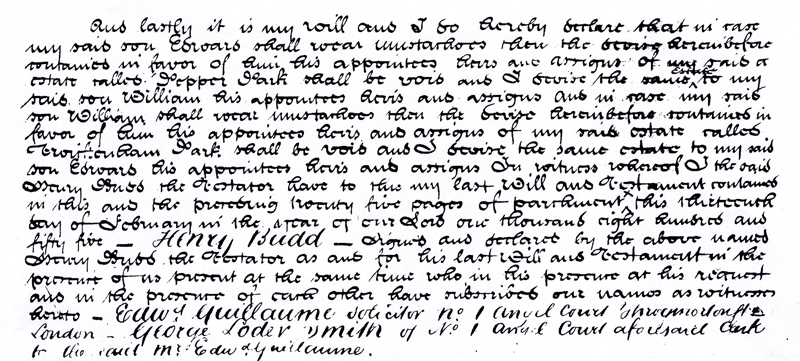
Detail from Budd's will in which he forbids his sons from ever growing mustaches
Posted By: Alex - Sat Jan 09, 2021 -
Comments (4)
Category: Law, Nineteenth Century, Hair and Hairstyling
Happy New Year’s Day, 2021!
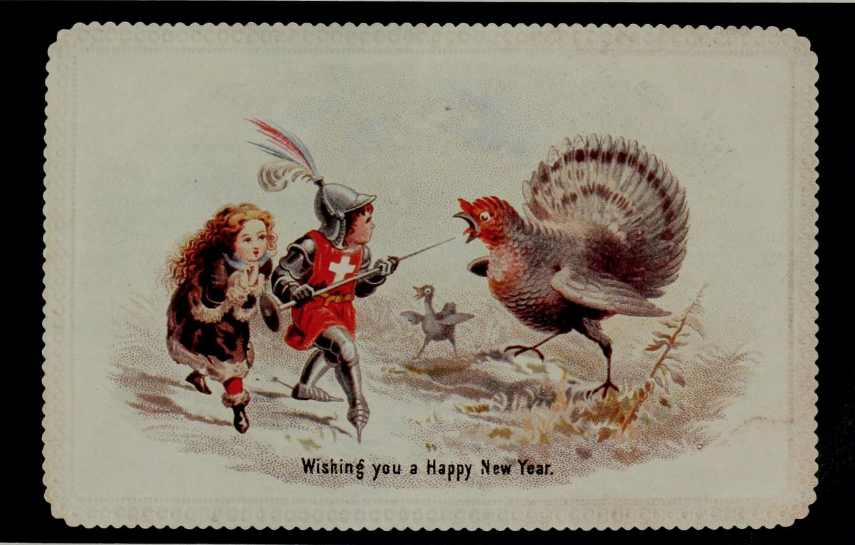
Posted By: Paul - Fri Jan 01, 2021 -
Comments (0)
Category: Holidays, Miniature People in Ads, Nineteenth Century
The Lives and Portraits of Curious and Odd Characters
Read the whole book here.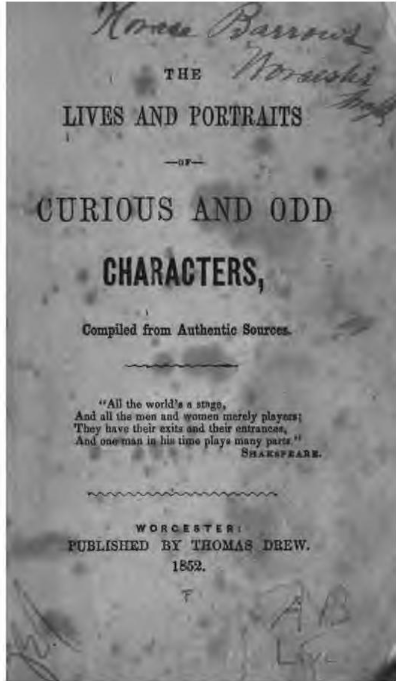
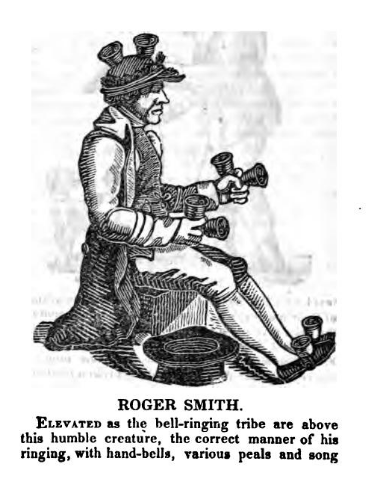
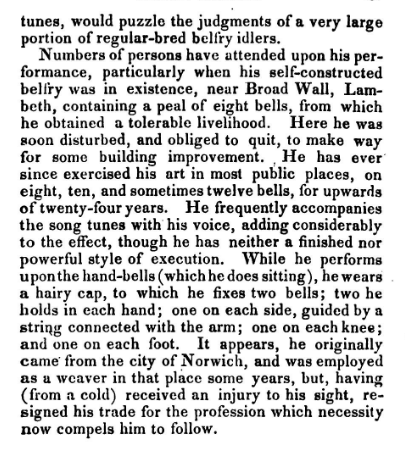
Posted By: Paul - Thu Dec 24, 2020 -
Comments (0)
Category: Eccentrics, United Kingdom, Nineteenth Century
The Navassars Ladies Band
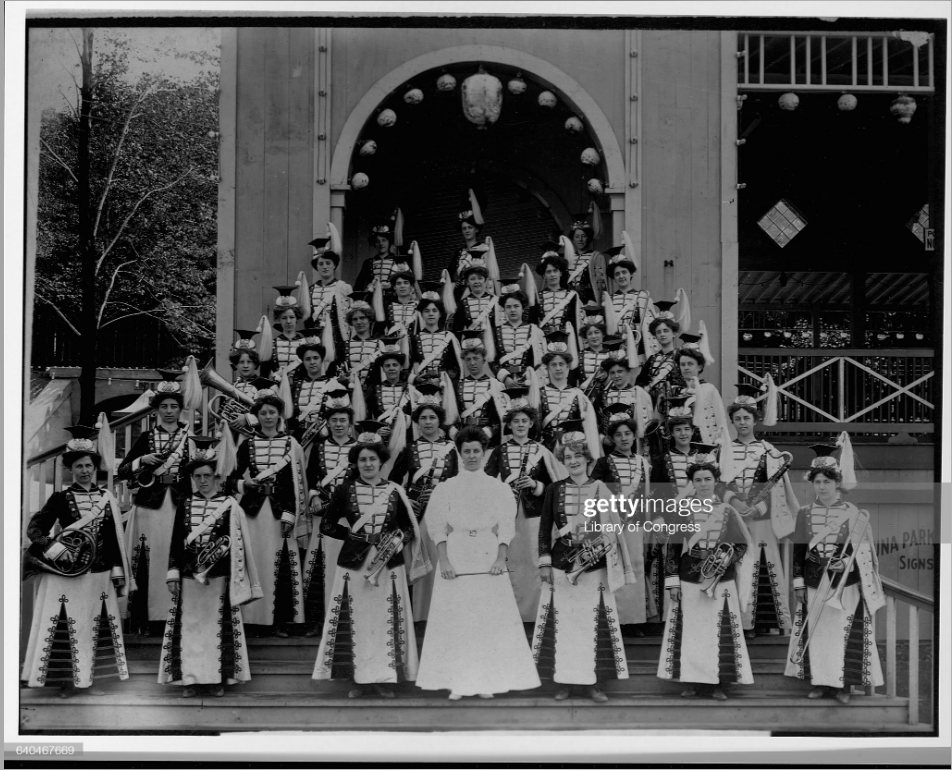
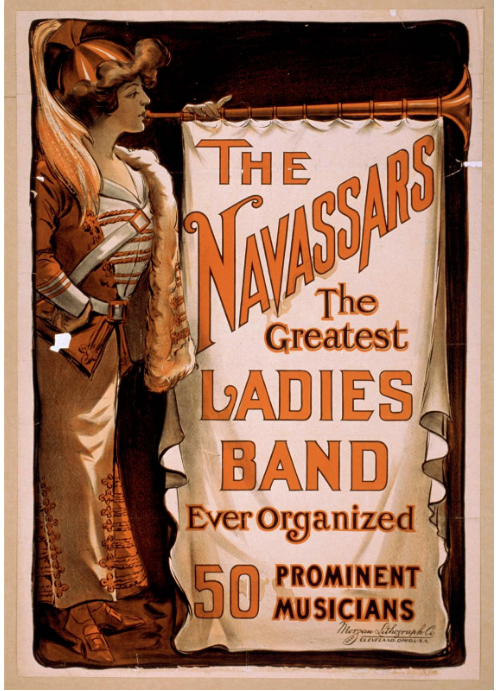
Posted By: Paul - Sat Dec 12, 2020 -
Comments (5)
Category: Music, Gender, Women, Nineteenth Century

| Who We Are |
|---|
| Alex Boese Alex is the creator and curator of the Museum of Hoaxes. He's also the author of various weird, non-fiction, science-themed books such as Elephants on Acid and Psychedelic Apes. Paul Di Filippo Paul has been paid to put weird ideas into fictional form for over thirty years, in his career as a noted science fiction writer. He has recently begun blogging on many curious topics with three fellow writers at The Inferior 4+1. Contact Us |




